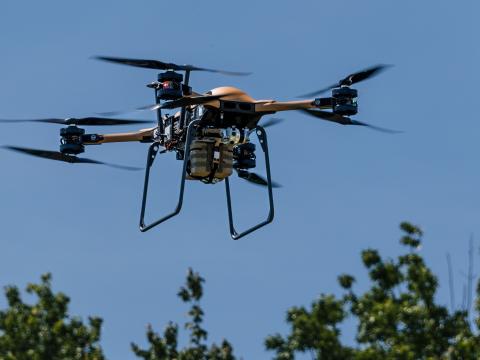Devil Dogs in Japan Fly Right
 |
Capt. John Helm, USMC, operations officer for Marine Aviation Training Systems Site (MATSS) Iwakuni, Japan, prepares for take-off in the F/A-18D Tactical Operational Flight Trainer (TOFT) 37. |
The latest version of an F/A-18D aircraft simulation has arrived at the only Marine Corps forward-operating location that houses a permanent squadron of the aircraft. Similar devices reside at stateside bases, but this newest version has enhancements that especially benefit users operating in restricted spaces. In addition to providing better training to Marines immediately, the simulator comes with a support contract that will keep it current with aircraft upgrades. The support process directly involves users so that alterations made to the device actually benefit aircrews in the way they need.
Marine Corps Air Station Iwakuni,
The major adds that the trainer has upgraded visuals and better fidelity for flying in formation compared to the simulator Marines at Iwakuni used previously. However, unlike places in the
Technically, the TOFT at Iwakuni can connect to simulators at other locations. However, according to Maj. Blackmarr, information assurance issues prevent that from becoming reality. “The Marine Corps timeline for connecting simulators at different locations is still on the horizon, less likely in the end for
The squadrons at Iwakuni employ the simulator seven to eight hours a day depending on what users need for training requirements. L-3 Link Simulation and Training, the company that provided the simulator, temporarily stationed personnel at Iwakuni to operate the TOFT and train permanent personnel from other organizations to take over running the device.
As with other simulators, the TOFT 37 replicates environments inaccessible in real-world training. Maj. Blackmarr says this is even more important in overseas locations where aircrew face tighter restrictions on training missions because of working in another country’s territory. In
Another benefit to the new TOFT at Iwakuni is that it correctly replicates the aircraft that Marine Corps aircrew operate. Both the Navy and the Marine Corps fly F/A-18s, but Navy pilots use the C version while Marines fly the D model. The Navy’s aircraft has only one seat for a pilot, but the Marine Corps version has a seat and equipment for an aviator and for a weapons control officer. The TOFT for each model is configured to replicate the different aircraft. Maj. Blackmarr says having the right setup makes a huge difference. “Crew coordination is extremely important,” he states. Without a back seat in the TOFT, training in the simulator would be a detriment to aircrew. The simulator’s forward and aft seats reside in different rooms in the building that houses it, but they are integrated fully to offer realistic training. Each seat has an independent visual system, and aircrew have a 360-degree, outside-window display through the SimuSphere visual display system. The system combines satellite imagery of the replicated theater enhanced with hand model targets.
The major says that in his opinion the “coolest feature” of the new trainer is the simple fact that it mirrors the aircraft system his aircrews fly. He shares that with the previous simulator aircrews used at Iwakuni, personnel received almost negative training because of the differences between the trainer and the physical aircraft. Because of the quality of the training in the new TOFT compared to the former trainer, aircrew members are using simulation training more often than they did in the past. With the TOFT 37, aircrews experience concurrency between the trainer and jets in areas such as the sensor, weapons and reconnaissance systems as well as the aircraft capabilities.
Maj. Blackmarr would like to see improvement in the artificial intelligence that replicates enemies and surface-to-air threats as well as an even greater increase in some of the fidelity. He says those factors and the inability to connect to additional TOFTs create a hole in the training.
Other issues surrounding the simulator installation at Iwakuni were larger-scale and more contentious. The first was diplomatic, as the
 |
Capt. John Helm, USMC, MATSS Iwakuni operations officer, demonstrates some of the F/A-18D TOFT 37’s capabilities. |
Instructors use the MOC during missions to control the environment and observe in real time what the pilot sees. It also streams the audio communications from the operation. Displays in the room show various images from the cockpit and the environment for trainers and other observers. Because the TOFT at Iwakuni is the newest to roll out, it also has the latest generation of audio systems, which Casano says are two generations beyond what the rest of the fleet uses.
All 24 F/A-18C and D Navy and Marine Corps TOFTs that L-3 supports will be subject to a regular series of upgrades, and the user community can request unscheduled enhancements as it identifies them. The Roadmap Procurement Program is an effort between industry, the acquisition community and the user community to deliver necessary concurrency and fidelity upgrades to keep the simulators relevant as well as to offer aircrew the ability to ask for changes.
Soon after Iwakuni personnel received their TOFT, a need was identified for an enhanced database to fly additional parts of the globe. Casano expects to deliver an Asian database to cover sectors of that continent soon. Upgrades made to one TOFT eventually will be delivered to the rest.
Usually, upgrades take place two to three times a year on each machine in an effort to keep the trainer matched up with the enhancements made to the two types of F/A-18s. This ensures that aircrew train as they fly. “Our goal is to deliver [TOFT updates] as close as possible to the F/A-18 receiving updates,” Casano explains. L-3 is under contract to deliver regular, preplanned upgrades through 2013. These include increases of fidelity to the synthetic environment database, to the visuals out the windows and to weapons systems as well as adjustments for aircraft concurrency. The involved groups meet regularly to discuss upcoming work and changes.
L-3 fielded its first devices at Marine Corps Air Station Miramar,
The way in which the Marines at Iwakuni will handle those changes, as well as all the responsibilities for the TOFT 37, also is relatively recent. Traditionally, the Iwakuni air station had ownership and maintenance responsibilities for simulators. The Marine Corps has changed that through the establishment of a MATSS at the base, which has the ownership for the simulator as well as the maintenance and operation roles. Maj. Blackmarr says the transfer in ownership is important, adding that simulator problems in the past have been blamed on the lack of concurrency and high quality resulting from air station ownership. Because the station personnel were more administrators than operators, they sometimes lacked the best people to serve as proponents for changes that needed to be made.
This type of ownership alteration is not unique to Iwakuni. The major explains that the Marine Corps is implementing MATSSs across its air stations. In the past, the Marine Corps air stations at each location signed for the equipment, then housed and maintained it. Now the MATSS at each location is in charge of the local management, training systems, simulators, classrooms and other materials. This change means that the operators instead of administrators control the assets. The users are able to make changes and provide direct input. “That’s a big dynamic change in the way we do business in the Marine Corps,” Maj. Blackmarr says.
WEB RESOURCES
Marine Corps Air Station Iwakuni: www.marines.mil/unit/mcasiwakuni
L-3 Flight Simulation: www.link.com/aircrew-training.html



Comments